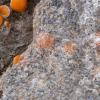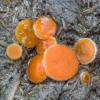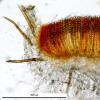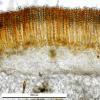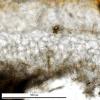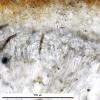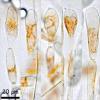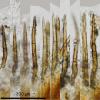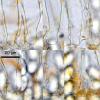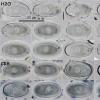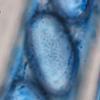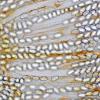
30-12-2025 16:44
Pascal DucosBonjour,Une anamorphe rose stipitÃĐe, trÃĻs nombre

30-12-2025 17:14
 Bernard CLESSE
Bernard CLESSE
Bonjour à toutes et tous,Pourriez-vous aider Albe

29-12-2025 10:15
Hulda Caroline HolteHello, I found and collected this propoloid ascom

30-12-2025 09:04
Hello.A Pyrenomycete sprouting sparsely but very d

29-12-2025 17:44
Isabelle CharissouBonjour,J'aimerais savoir si d'autres personnes au

12-11-2021 00:03
Lepista ZacariasHi everybody,A week ago in my fiels trip I noticed

29-12-2025 17:12
 Bernard CLESSE
Bernard CLESSE
Bonjour à toutes et tous,Pourriez-vous m'aider Ã
 Good morning
Good morningI know August is a holiday month, but now I have time to send this species.
This Cheilymenia was in a snowfield (see first picture) and I think there is not doubt about his identification, but I prefer your opinion.
Spores eliptical and slightly ornamented, size (18.6) 19.3 - 21.9 (22.5) x (10.3) 10.6 - 11.7 (12.9) Âĩm;Â Q = (1.6) 1.7 - 2.0 (2.2) ; N = 91;Â Me = 20.6 x 11.2 Âĩm ; Qe = 1.9.
Hairs size (222.7) 235.0 - 401.2 (435.2) x (16.4) 19.1 - 27.5 (37.2) Âĩm
N = 27; Me = 319.6 x 23.9 Âĩm
Moniliform paraphysis and croziers.
Hifal system at base very developed.Â
Thank you for your opinion

You do not specify the substrate, but it looks good on the picture that there is dung. This is a difficult species to determine, but I think C.denissi corresponds to your description. Have you also checked the length of asci?
Michel.

Of course, substrate is cow dung, and this are measures of living asci at 600x:
(267.5) 280.0 - 310.6 (326.3) x (17.1) 17.6 - 20.4 (21.2) Âĩm; N = 24; Me = 295.6 x 19.1 Âĩm
Why is so difficult to determine this species? According to Moravec, the nearest species is C. liskae, who have shorter hairs (90-300 x 10-30), bi, tri o multifurcate; asci shorter and wider (150-180x18-27) and longer spores (18-22,5 x 10-13).
The doubt is that Moravec spores measure for C. denisii are 14-21 x 8-13,5, and asci 170-240 x 13,5-18, both shorter than mine, perhaps died material?
Thank you Michel

surely the asci show such enormous shrinkage as is seen between your and Moravec's ascus sizes. The spore data are more equal when considering perhaps immature spores included in Moravec's data. Moravec probably mostly measured dead elements as far as I know his papers.
I have only a few pages of Moravec's monograph. On Fig. 23 I wonder why he figured a dead (b) and a living ascus (c) and addressed them to different varieties. Was he unaware of ascus shrinkage?
In your sample I am impressed especially of the carotenoid crystals in the paraphyses. I know this feature only in Scutellinia, and in one species of Cheilymenia (crucipila), which was later transferred to Scutellinia, I think for molecular reasons.
Maybe Cheilymenia dennisii is also a masked Scutellinia despite of the low lipid content in the spores?
Â
Zotto

I think my measures are on living state (attached picture).
Another discrepance with Moravec is about croziers, he said no croziers, and I think mine has it.
Very interesting hypothesis about Cheilymenia / Scutellinia Âŋ?, of course I have no answer.
Thank you

But I was wondering about the ascus base, it looks to me like lacking croziers.

Thanks.



